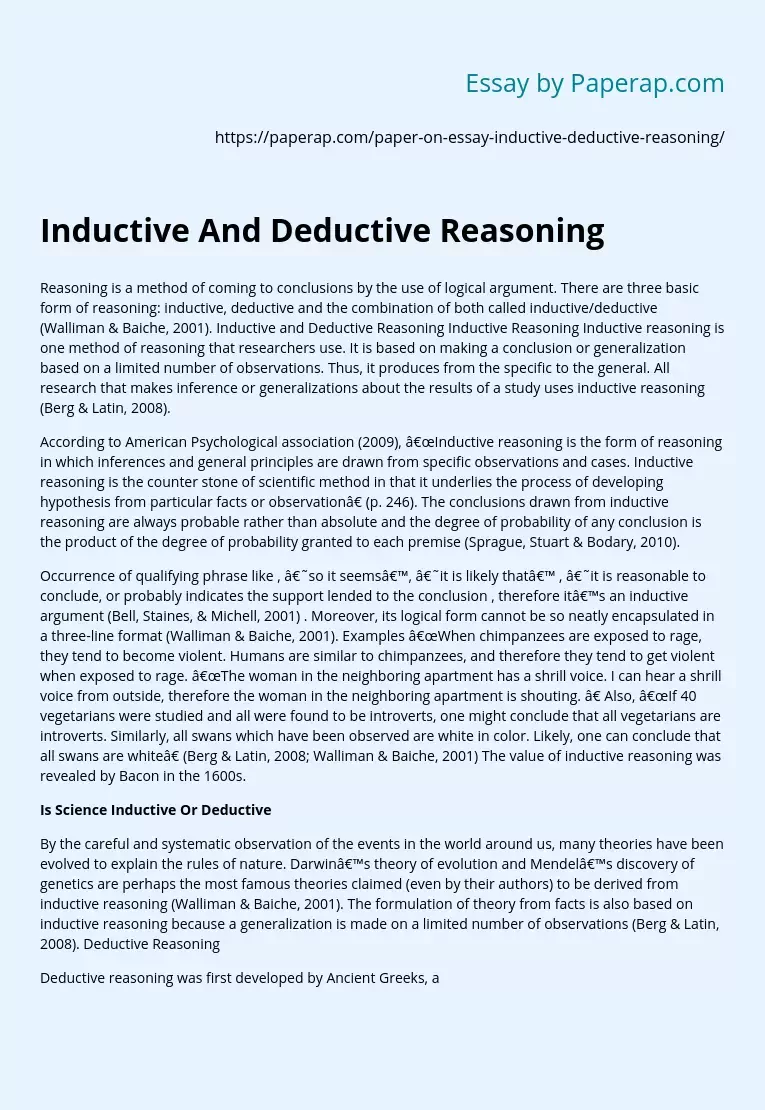Inductive And Deductive Reasoning
Reasoning is a method of coming to conclusions by the use of logical argument. There are three basic form of reasoning: inductive, deductive and the combination of both called inductive/deductive (Walliman & Baiche, 2001). Inductive and Deductive Reasoning Inductive Reasoning Inductive reasoning is one method of reasoning that researchers use. It is based on making a conclusion or generalization based on a limited number of observations. Thus, it produces from the specific to the general. All research that makes inference or generalizations about the results of a study uses inductive reasoning (Berg & Latin, 2008).
According to American Psychological association (2009), “Inductive reasoning is the form of reasoning in which inferences and general principles are drawn from specific observations and cases. Inductive reasoning is the counter stone of scientific method in that it underlies the process of developing hypothesis from particular facts or observation” (p. 246). The conclusions drawn from inductive reasoning are always probable rather than absolute and the degree of probability of any conclusion is the product of the degree of probability granted to each premise (Sprague, Stuart & Bodary, 2010).
Occurrence of qualifying phrase like , ‘so it seems’, ‘it is likely that’ , ‘it is reasonable to conclude, or probably indicates the support lended to the conclusion , therefore it’s an inductive argument (Bell, Staines, & Michell, 2001) . Moreover, its logical form cannot be so neatly encapsulated in a three-line format (Walliman & Baiche, 2001). Examples “When chimpanzees are exposed to rage, they tend to become violent. Humans are similar to chimpanzees, and therefore they tend to get violent when exposed to rage.
“The woman in the neighboring apartment has a shrill voice. I can hear a shrill voice from outside, therefore the woman in the neighboring apartment is shouting. ” Also, “If 40 vegetarians were studied and all were found to be introverts, one might conclude that all vegetarians are introverts. Similarly, all swans which have been observed are white in color. Likely, one can conclude that all swans are white” (Berg & Latin, 2008; Walliman & Baiche, 2001) The value of inductive reasoning was revealed by Bacon in the 1600s.
Is Science Inductive Or Deductive
By the careful and systematic observation of the events in the world around us, many theories have been evolved to explain the rules of nature. Darwin’s theory of evolution and Mendel’s discovery of genetics are perhaps the most famous theories claimed (even by their authors) to be derived from inductive reasoning (Walliman & Baiche, 2001). The formulation of theory from facts is also based on inductive reasoning because a generalization is made on a limited number of observations (Berg & Latin, 2008). Deductive Reasoning
Deductive reasoning was first developed by Ancient Greeks, and was refined by Aristotle through his deductive syllogisms. It is reverse of inductive reasoning. It produces from the general to the specific. An argument based on deduction begins with general statements and, through logical argument, comes to a specific conclusion. A syllogism is the simplest form of this kind of argument and consists of a major general premise (statement), followed by a minor, more specific premise and a conclusion which follows logically (Walliman & Baiche, 2001; Berg & Latin, 2008).
According to American Psychological association (2009) “Deductive reasoning is the form of reasoning in which a conclusion is shown to follow necessarily from a sequence of premises, the first of which stands for a self-evident truth or agreed upon data. In empirical sciences, deductive reasoning underlies the process of deriving and predicting from general laws or theories” (p. 130). Occurrence of the word, ‘necessarily’ or ‘therefore’ is a sign that the argument is deductive. (Bell, Staines, & Michell, 2001) Example: All live mammals breathe. This cow is a live mammal. Therefore, this cow breathes.
One of the real advantages of structuring ideas deductively is that they state relationship among the concepts one is dealing. Once the major premise on which the argument rests is stated, certain values, assumptions and even logical truisms can be applied to the specific cases in minor premise. Deductive argument is an elegant way to justify a conclusion, even when it has been modified to lose the clean force of syllogism (Sprague, Stuart & Bodary, 2010). For example, It has always been the goal of our social welfare system to help the recipients become self sufficient.
Certain current programs encourage dependency and discourage initiative. Therefore, these programs should be changed. A good friend is a person who helps you reach your potential. Several people in this organization have helped me strive towards my potential. Therefore, as I say good-bye, I feel like I am leaving a number of good friends. (Sprague, Stuart & Bodary, 2010) The application of research is also based on deductive reasoning. It may be assumed or deduced that what occurred in sample of subjects in a study may also occur in other people similar to the subjects.
If estrogen replacement therapy was found in a study to increase bone density of postmenopausal women, one might deduce that a similar change might occur in one’s 60-year-old aunt and encourage her to see her physician about it (Berg & Latin, 2008). When inductive and deductive reasoning were combined to form inductive/deductive reasoning, the to-and-fro process of developing hypothesis (testable theories) inductively form observations, chattering their implications by deduction, and testing them to refine or reject them in the light of the results, formed a powerful basis for the progress of knowledge, especially of scientific knowledge.
Thus, it is the combination of experience with inductive and deductive reasoning which is the foundation of modern scientific research (Walliman & Baiche, 2001).
Inductive And Deductive Reasoning. (2019, Dec 05). Retrieved from https://paperap.com/paper-on-essay-inductive-deductive-reasoning/

